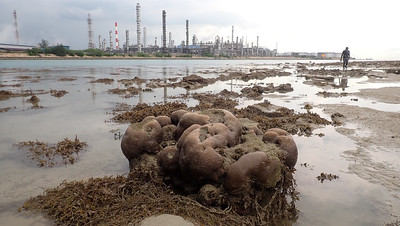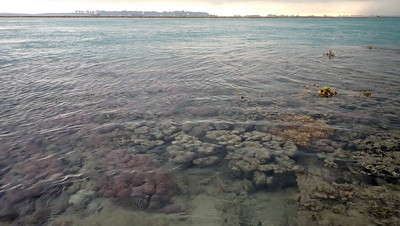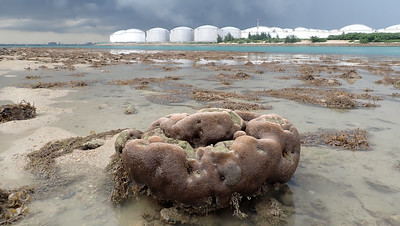It was good to see that these ecosystems were doing well, similar to our last survey in Apr 2021. Despite the rain, the team managed to do a quick health check and also saw interesting marine life.
Today, I saw many healthy, large, well-formed colonies of hard corals of various kinds, similar to our last survey here in Apr 2021. I couldn't take good photos of them as the rain came in soon after we reached the reef edge.
I was particularly happy to see about 5 Sunflower mushroon corals. These are not commonly seen on our shores and Pulau Hantu was one of the last few shores where we can still find them. As usual, there were also many of the other kinds of mushroom corals, with many large ones.
It was great to see the usual variety of corals on the shore, and most were not bleaching. I saw large colonies of Anemone coral, Galaxy coral and Anchor coral. I didn't get to the reef edge where the Branching horn corals is. Most of the large Pore coral colonies were alright, but I saw some large ones in the big lagoon that were pale. The patches of Branching montipora near the seawall are still doing well.There were many large leathery soft coral colonies of various kinds.
Also many Asparagus flowery soft corals. I didn't see any that were bleaching.I saw the usual common animals in the reefs: A large Saw-edged spooner crab, the usual common nudibranchs and flatworms. There were many Giant carpet anemones and Frilly anemones. In the big lagoon, among the interesting animals I saw were a Fire anemone, a large Upside down jellyfish and many Common sea stars. The rest of the team saw more!

Mangroves have settled naturally on the artificial seawall around the northern lagoon. I had earlier noticed this in Apr 2009 (although they were probably growing there much much earlier). The trees are still doing very well!
There are a wide variety of mangroves including some rarer species. They were all alright, with fresh green leaves and producing flowers and propagules. This is similar to what I saw when I looked at them Apr 2021.
Soon after we reached the reef edge, the rain hit us. I didn't see any long Tape seagrasses, there were only a few cropped ones outside the seawall. I didn't really check up much of the big lagoon. There were also sprinkles of Spoon seagrasses.
It was nice to see several guided walks going on at Pulau Hantu this low tide.
What is the fate of Pulau Hantu?
Pulau Hantu is one of the existing natural shores that may be impacted by the landuse plan by the Ministry of National Development released in Jan 2013 in response to the Populations White Paper with a 6.9 million population target. The dotted margined blue areas are "Possible Future Reclamation".
Let's hope these shores will be spared this fate.
The Singapore Blue Plan 2018
Pulau Semakau and nearby islands (like Pulau Hantu) and submerged reefs have been recommended by the Singapore Blue Plan 2018 for Immediate Conservation Priority.
The Blue Plan recommends the intertidal and subtidal marine areas of Pulau Semakau and adjacent Pulau Hantu, and Pulau Jong to be designated Marine Reserve.
The Blue Plan highlights that Pulau Semakau and its associated patch reefs comprise many ecosystems: coral reefs, mangrove areas, intertidal sandflats, seagrass meadows, and coral reefs. The subtidal area of Pulau Jong is larger than the terrestrial area.
Pulau Hantu is a popular dive site has seen increasing interest in the past decade due to biodiversity awareness. If protection is accorded to these three islands, zonation plans for use can be implemented to manage tourism and human impacts.
DOWNLOAD the Plan, SUPPORT the Plan! More on the Singapore Blue Plan 2018 site.
Photos by others on this survey
Kelvin Yong
James Koh
Marcus Ng
Che Cheng Neo













